The Lawmatics Blog
Insights on legal marketing, automating the law practice, and legal tech in general
As we head toward the end of the year, our team revisited the most meaningful product updates of 2025 and how they’re reshaping the way firms work. All year long, our product work has centered on the same core goal: removing the obstacles that slow firms down. That’s meant bringing key information to the surface when teams need it, cutting out friction in the client journey, and giving staff clearer ways to build and maintain their processes across the platform.
Time stamps of key takeaways
8:15 – New, intuitive navigation
Devon walks through the redesigned navigation, which brings the most-used areas — like Matters, Pipeline, Calendar, Tasks, and Automations — into a cleaner, left-hand layout for quicker access. Reminders, emails, and other tools that had previously been scattered across the app now live in central, easy-to-find locations. The goal is simple: fewer clicks, clearer groupings, and a workspace that reflects how firms actually move through intake.
26:20 – Get key info faster with MMS
The team shows how firms can now receive MMS messages directly into Lawmatics, allowing clients to text photos or documents straight into their matter. It’s especially useful for practices like personal injury, where images of an accident or ID documents are often needed quickly.
31:18 – Manage your emails in one place
Email tools have been fully centralized, replacing the old model where templates lived in different corners of the app. Everything — from document send templates to automation emails — can now be created, edited, and organized in one place. Folders help firms manage growing libraries of emails, and each template can be applied across multiple documents without duplicate versions.
36:55 – Build and maintain automations with less effort
Devon and Clare highlight the refreshed automation experience, which makes appointment-based and date-based workflows easier to find, build, and understand. Relative timing is now built directly into each automation, and shared entry rules help firms avoid recreating the same logic dozens of times. Automation builds can also now be grouped in folders, similar to how you organize your email library.
45:18 – Additional highlights
The session closes with a handful of smaller but long-requested additions, including improvements to round-robin scheduling, password-protected forms, Message Center filters, auto-pay for billing, and color-coded appointment types to make dense calendars easier to read.
Webinar slide deck
Running a law firm means managing a lot of moving parts — from new inquiries and consultations to signed agreements and onboarding, let alone billable work. The more your pipeline grows, the more important it becomes to have systems that keep everything moving smoothly and nothing falling through the cracks. That’s where automation steps in — not just to save time, but to help you build a more scalable, conversion-ready intake process.In this month’s Deep Dive, Lawmatics Product Manager Devon Roth is joined by Clare Struzzi, manager of the account management team, to walk through how to get even more out of your automations and pipeline setup, so your firm can continue to grow.
Time Stamps of Key Takeaways
4:50 — Build an intentional pipeline
The webinar kicks off with Devon and Clare outlining how to build a clean, intentional intake pipeline that works across all practice areas. Rather than juggling multiple pipelines, they recommend one universal structure with milestone-based stages. Clare also shares tips from onboarding calls about using filters and tags to keep it flexible without adding complexity.
9:22 — Automate key workflows
In this section, Devon demonstrates how automations can replace manual tasks — like sending emails, changing statuses, or converting leads — so your team can focus on high-touch client work. The takeaway: Automation isn’t just about speed — it’s about setting your firm up to scale responsibly.
27:00 — Using triggers and actions
This section covers the full automation lifecycle, from what sets a workflow in motion to what happens next. Devon breaks down key trigger types like form submissions, document completions, and field updates, then transitions into a demo of how to stack actions such as emails, tasks, delays, and conditionals. Clare adds strategic context around using advanced logic, testing automations with dummy matters, and avoiding common missteps.
43:59 — Exit conditions and next steps
In the final segment, Devon and Clare demonstrate how exit conditions ensure automations stop when a lead hires, is lost, or moves forward, preventing redundant follow-ups. A key example is the engagement agreement: Once it’s signed, Lawmatics can automatically convert the lead to a hired matter, trigger a welcome packet, and end any drip campaigns still running. Your hosts wrap by emphasizing the importance of sub-statuses for tracking lost leads and using conversion actions to maintain clean data and syncs across systems.
Webinar slide deck
When a client needs to send over a copy of their ID or an accident photo, they’re not looking for a complicated process. They don’t want to log into a portal, track down your email address, or dust off the household scanner. They want to do what they already do dozens of times a day: take a picture on their phone and hit “send.”Now, they can — directly to your firm’s text thread.We’re excited to introduce MMS messaging in Lawmatics, a new add-on feature that makes it easier than ever for clients to share what you need. With MMS enabled, your clients can send photos and other media files straight to your firm via text message, no extra steps required. It’s fast, convenient, and designed for the way people actually communicate today.And because it all flows into Lawmatics, your team gets complete visibility — without ever chasing an email or wondering where that document went.
Why law firms need MMS
Law firms have long used SMS in Lawmatics to confirm appointments, send reminders, and streamline the intake process. It’s a fast, reliable way to keep communication moving — especially during those early client interactions where speed and clarity matter most.Now, with the addition of MMS, there’s an even more convenient option when a client wants to share something visual. Whether it’s a photo of a document or an ID, clients can send it directly by replying to a text message — no need to switch to email or upload through another system.For clients who are on the go or not especially tech-savvy, it’s a natural extension of how they already use their phones. And for firms, it’s a simple way to keep all communication in one place. A quick handoff of information is especially useful in early-stage conversations, where momentum can mean the difference between a retained client and a lost opportunity. It also helps prevent small delays from snowballing; when an item isn’t in-hand, you can’t move forward.
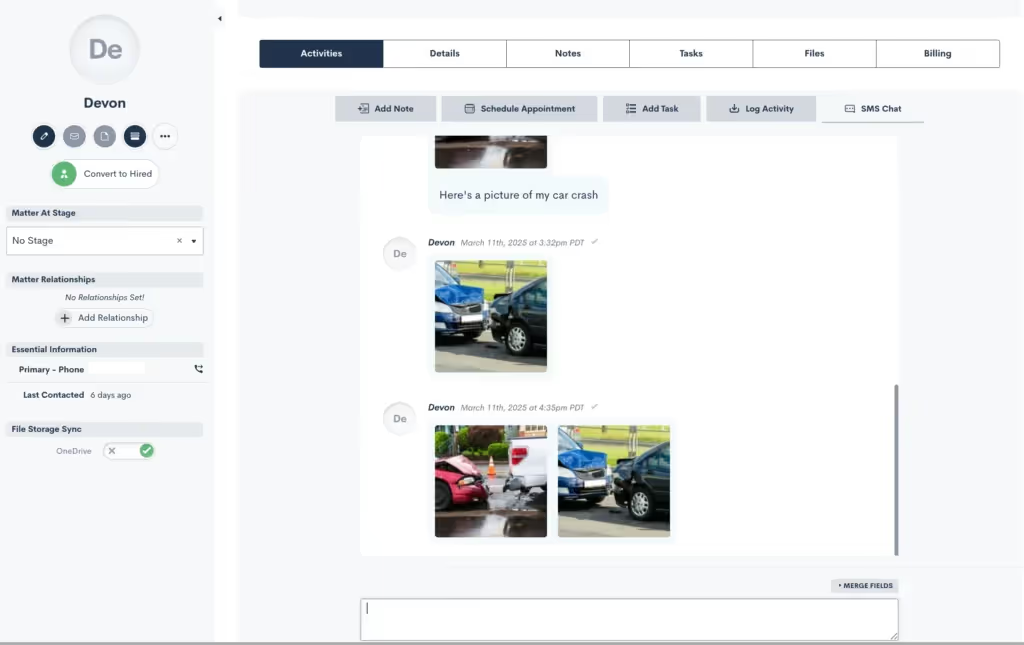
How MMS messaging works
MMS is an add-on feature that builds on your existing SMS capabilities in Lawmatics. Once enabled, clients can simply reply to your text with a file.Supported file types include standard formats like .jpeg and .png. You’ll see incoming media directly in the conversation thread within Lawmatics. From there, your team can take whatever next step is needed — whether that’s moving the intake forward, assessing the file in the client’s record, or triggering an automation based on the update.
Where MMS makes the biggest impact
While MMS is helpful across the board, in some practice types, the convenience can be a game-changer.Take personal injury, where documentation often includes real-time photos of injuries, accident scenes, or vehicle damage. Now, they can just text it, and you’ll receive it within seconds. And because Lawmatics is SOC 2 Type 2 and HIPAA compliant, your firm can safely receive even sensitive medical or personal records through MMS without worrying about where or how those files are stored.Alternatively, in immigration law, there’s often a long list of required documents: passports, visas, birth certificates, proof of residency, and more. Clients may not have ready access to email or may be coordinating with family members across borders. MMS lets them send what they have on hand right away, without needing a laptop or scanner.Even in estate planning, family law, or criminal defense, there are plenty of moments where a client needs to share a physical document, handwritten note, or piece of mail. With MMS, they can take a photo and send it through the text thread they’re already using to communicate with your firm. It’s easy, intuitive, and completely in line with how they already use their phones.
Built for a client-centered experience
For your firm, MMS means fewer delays, fewer follow-ups, and fewer dropped balls. For your clients, it means a legal process that feels more responsive and modern. Instead of “please send that via email when you get a chance,” they hear: “you can just text it.”And that shift matters. When clients feel like it’s easy to work with you, they’re more likely to follow through, stay engaged, and trust the process. And when your team has the files they need, exactly when they need them, they can serve clients more efficiently and effectively.
Getting started with MMS
At the end of the day, adding MMS support is about reducing friction in one of the most common parts of the legal journey: sharing photos and documents. Your clients expect to communicate with you as easily as they do with friends or family — and now, they can.If you're already using Lawmatics, enabling MMS is a simple upgrade. Once the feature is activated on your account, all incoming client messages will support media attachments, with no extra setup required on your end. To enable MMS for your firm, just reach out to your account manager or use this form to sign up.Not using Lawmatics yet? Get a demo to see how our platform helps law firms streamline communication, automate intake, and deliver a better client experience from day one.
In today’s competitive legal market, it’s not enough to simply have a digital presence — your online footprint needs to be fast, credible, and built to convert. In our latest webinar, we teamed up with the experts at Civille to break down exactly how law firms can strengthen their online presence and turn digital interest into real-world results. From the latest changes in search behavior to practical steps you can implement right away, here’s a recap of the insights.
Panelists

Blake Roberts
Director of Business Development,Lawmatics

Jess Stricklin
VP of Sales,Lawmatics

Eric Giroux
COO,Civille

Wes Lungwitz
Co-founder & Managing Partner,Civille
Time stamps of key takeaways
8:53 — The evolving digital landscape
Eric opened with a look at how the digital game is changing in 2025. The “mobile-first” mindset is more important than ever — but now it’s about fast-loading, lightweight content that works well even on weak mobile connections. He showed how Google’s AI-generated overviews are shifting how search results appear and explained why law firms should aim to be the source of the answers Google displays.
17:00 — Key components of a high-converting digital presence
The panel discussed what makes a website not just visible, but effective. Eric broke down how multi-step forms reinforce that a firm understands a visitor’s specific needs. Wes emphasized the value of regularly publishing useful, localized content and pointed to “E-E-A-T” (experience, expertise, authority, trust) as the standard Google uses to determine credibility. Reviews, case studies, and an optimized Google Business Profile also play a major role in turning visits into leads.
38:41 — Turning digital traffic into clients
This section focused on bridging the gap between traffic and conversion. Eric gave a live demo of an example using Lawmatics, showing how an appointment booked on a website instantly populates in the software. Jess then explained how automated workflows pick up from there, sending intake forms, confirming appointments, and triggering next steps. For firms struggling to keep up with growing lead volume, automation was framed as not just helpful, but essential.
53:11 — Actionable steps for law firms
To wrap things up, the team shared practical takeaways for firms at any stage. Blake and Jess emphasized that while these strategies take effort, they’re designed to scale — and the payoff is worth it. From tightening your Google Business Profile to embedding smarter forms and building automated intake flows, every step helps create a more seamless, client-ready digital presence.
Webinar slide deck
SAN DIEGO, March 25 — Lawmatics, the leading growth platform for law firms, proudly announces its achievement of Service Organization Controls (SOC) 2 Type 2 and Health Insurance Portability and Accountability Act (HIPAA) compliance, verified by an independent auditor. This assessment affirms that Lawmatics adheres to the highest standards of data security, availability, and confidentiality.“For firms handling sensitive data, like personal injury practices managing medical records, strong security is mission-critical,” said Matt Spiegel, co-founder and chief executive officer of Lawmatics. “Law firms don’t have to choose between using powerful cloud technology and protecting their clients’ data. Lawmatics makes sure they get both.”Established by the American Institute of Certified Public Accountants (AICPA), SOC 2 verification requires companies to implement rigorous controls around security, availability, processing integrity, confidentiality, and privacy. A Type 2 assessment evaluates the effectiveness of these policies over an extended period, ensuring continuous adherence to best practices.Separately, HIPAA sets strict guidelines for how organizations handle protected health information. HIPAA compliance ensures that any law firm handling medical or health-related legal matters can confidently use the platform while knowing their data is safeguarded to the highest industry standards.“We’ve built our platform with security at its core,” said Krijn van der Raadt, chief technology officer for Lawmatics. “Achieving SOC 2 and HIPAA compliance isn’t just about meeting industry standards — it’s about giving our customers peace of mind that their data is secure, no matter what.”Lawmatics’ SOC 2 report is available upon request for law firms requiring additional security verification.
Running a law firm means juggling a million moving pieces — marketing, client communication, team workflows, and of course, getting paid. Wouldn’t it be nice if more of that just... took care of itself? In our latest Deep Dive webinar, we shared some exciting new features designed to do just that.Your hosts, Lawmatics Product Manager Devon Roth and Sr. Director of Customer Success Johnny Bissell, walked through the newest and upcoming features designed to help law firms work more efficiently and drive growth. From enhanced marketing integrations to improved communication tools and smarter financial workflows, these updates are built to make a real impact on your firm’s success.
Time Stamps of Key Takeaways
9:00 — Google ads integration improvements
Google Ads integration has been enhanced to automatically import UTM values from your ad campaigns. This means that instead of manually tracking and entering UTM data, Lawmatics will now capture it automatically and sync it to your marketing sources. Additionally, Google Click IDs (GCLIDs) are now supported, allowing for more precise conversion tracking.For firms investing in Google Ads, this update eliminates the hassle of manually tracking ad performance. With automatic UTM imports and GCLID tracking, firms can send offline conversion data back to Google via Zapier, providing a clearer ROI picture for paid campaigns.
16:18 — MMS messaging
One of the most highly requested features, MMS messaging, is coming soon to Lawmatics! While firms have long been able to send and receive standard text messages, this new functionality allows clients to send images directly via text. This is particularly valuable for personal injury and family law firms, where clients frequently need to share accident photos, medical documents, or other case-related images.
23:25 — User activity reports
To enhance firm oversight and productivity tracking, Lawmatics is introducing User Activity Reports. These reports will log every action taken by every user, including emails sent, SMS activity, document shares, appointments scheduled, and more. With filtering options by user, action type, and date range, firms can quickly analyze performance, identify trends, and optimize workflows.
33:14 — Surcharging
For firms using LMPay Version 2, a new surcharging option allows firms to automatically add a 3% processing fee to credit card transactions. This helps firms offset processing costs without increasing service fees for all clients.
Webinar slide deck
We know running a law firm means juggling a ton of software. And while each tool is supposed to make things easier, sometimes it feels like they just add more to your plate with duplicate data entry, wasted time, and clients who feel neglected.That’s exactly why we’d like to spotlight our Lawmatics integration with MyCase, one of the leading case management platforms. With this powerful connection, you can manage the entire client lifecycle — from initial inquiry to case resolution and beyond — without the hassle of manual data transfers.
What this integration does for you
Your team shouldn’t have to spend time manually copying client details from one system to another. Technology should lighten the administrative load, not add to it. By linking Lawmatics with MyCase, you get a frictionless transition from client intake to case management, ensuring a more efficient workflow and a better experience for both clients and your team.
A smooth connection from Lawmatics to MyCase
Lawmatics users can automatically or manually sync matters over to MyCase. Any records that have been created in Lawmatics as matters will be pushed into MyCase along with corresponding details like notes and files.
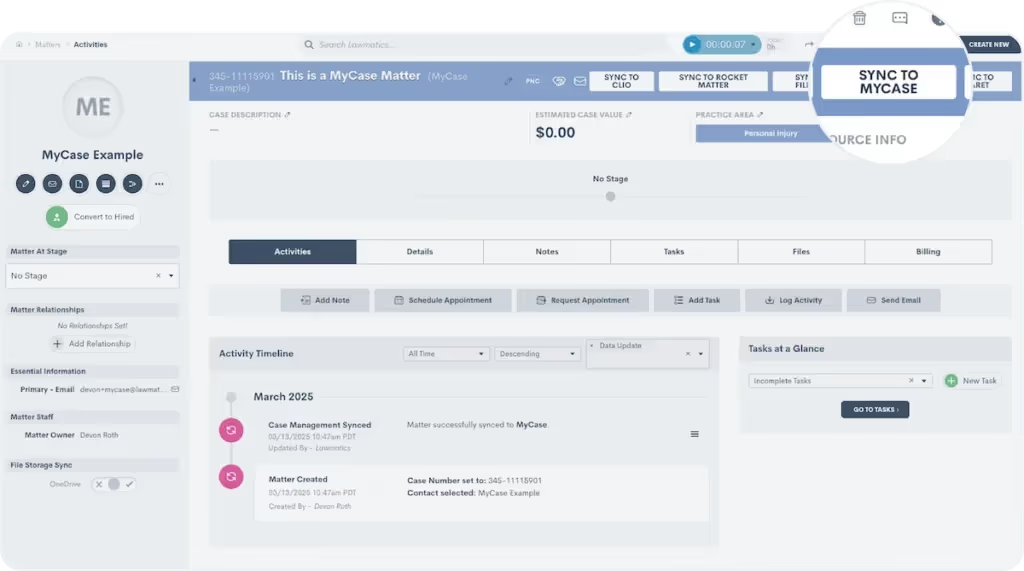
Activating the integration takes just moments. From there, you can define triggers that automatically transfer matter details to MyCase. For example, once a client signs an engagement agreement in Lawmatics, their case file can instantly sync to MyCase, keeping everything up to date without extra effort from your team.
Sync matter details and files automatically
When integrating MyCase with Lawmatics, you can map custom fields from Lawmatics to custom fields in MyCase. Plus, when a matter syncs or converts from Potential New Client to Hired, any files attached to the existing matter in Lawmatics will also move over to MyCase.
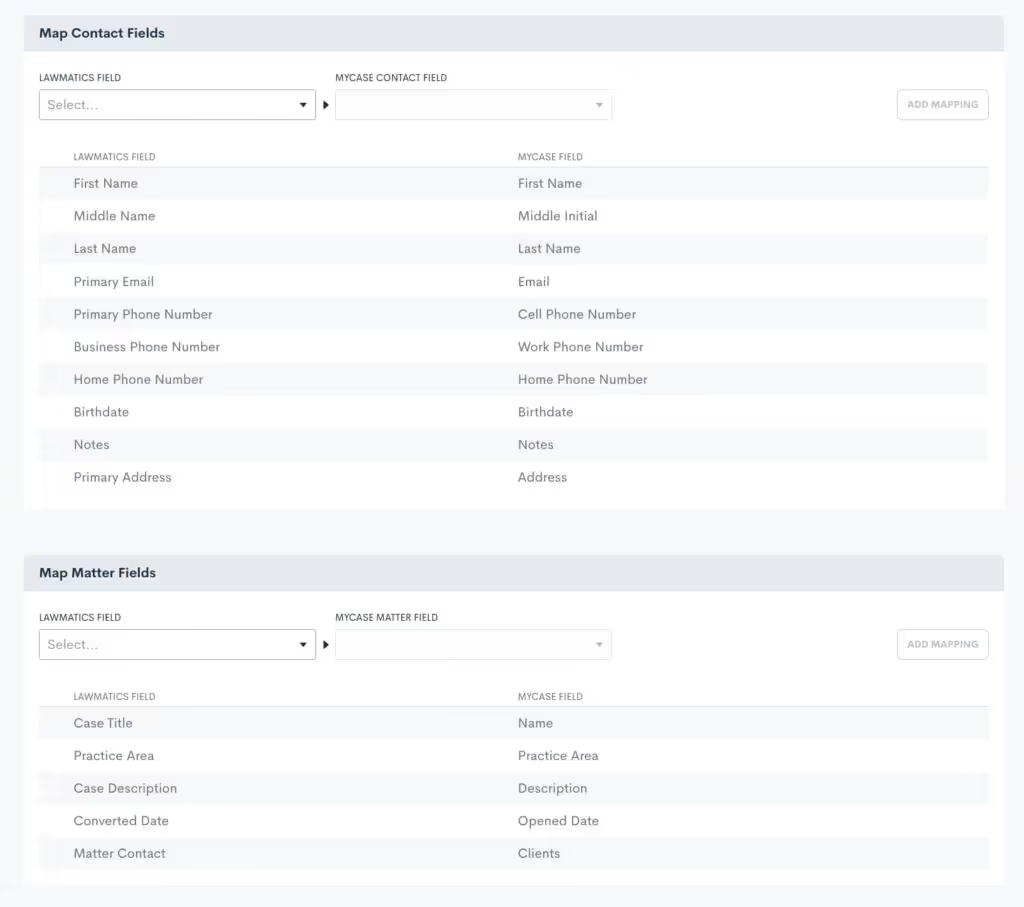
All of the manual work of making sure all details and relevant files get moved over to MyCase will be taken care of on the Lawmatics integration page.
How to integrate Lawmatics and MyCase
Already using both platforms? Setting up the integration is quick and easy. Just head to the integration settings page in Lawmatics, click the MyCase icon, and follow the simple connection steps. You’ll need your MyCase login credentials, so have those handy. For more information, please visit our Help Center.

Get started with Lawmatics + MyCase
If you’re a MyCase user looking for a better way to manage client intake, schedule a demo with Lawmatics today and see how our growth platform can take your firm to the next level.For more details on this and other Lawmatics integrations, check out our dedicated integrations page.
Subscribe to get our best content in your inbox
Ready to grow your law firm with Lawmatics?
Schedule a demo of legal’s most trusted growth platform.
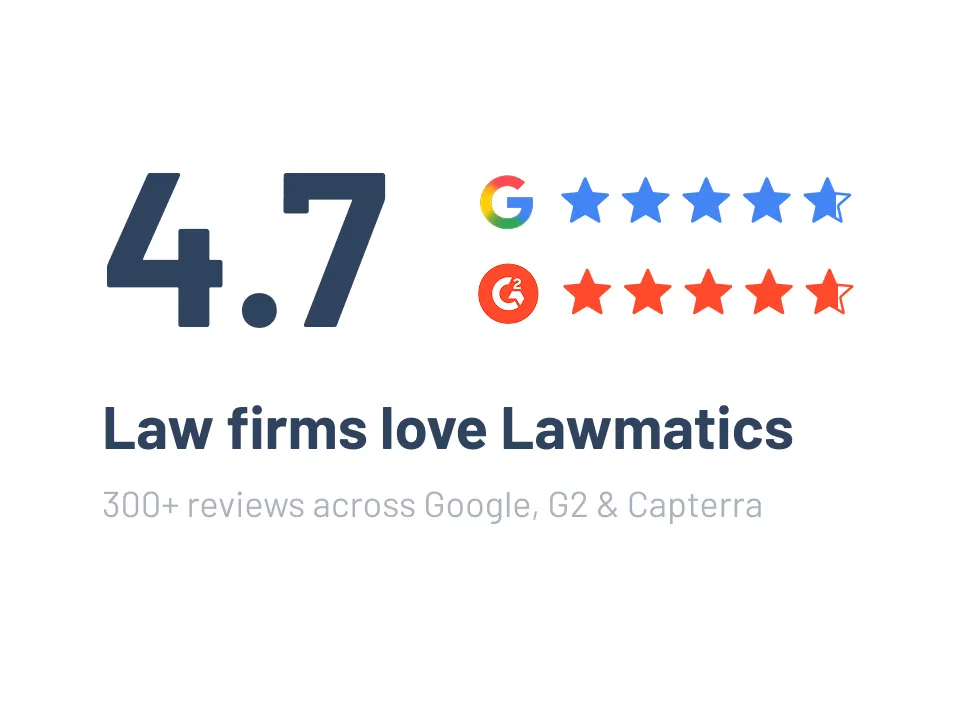







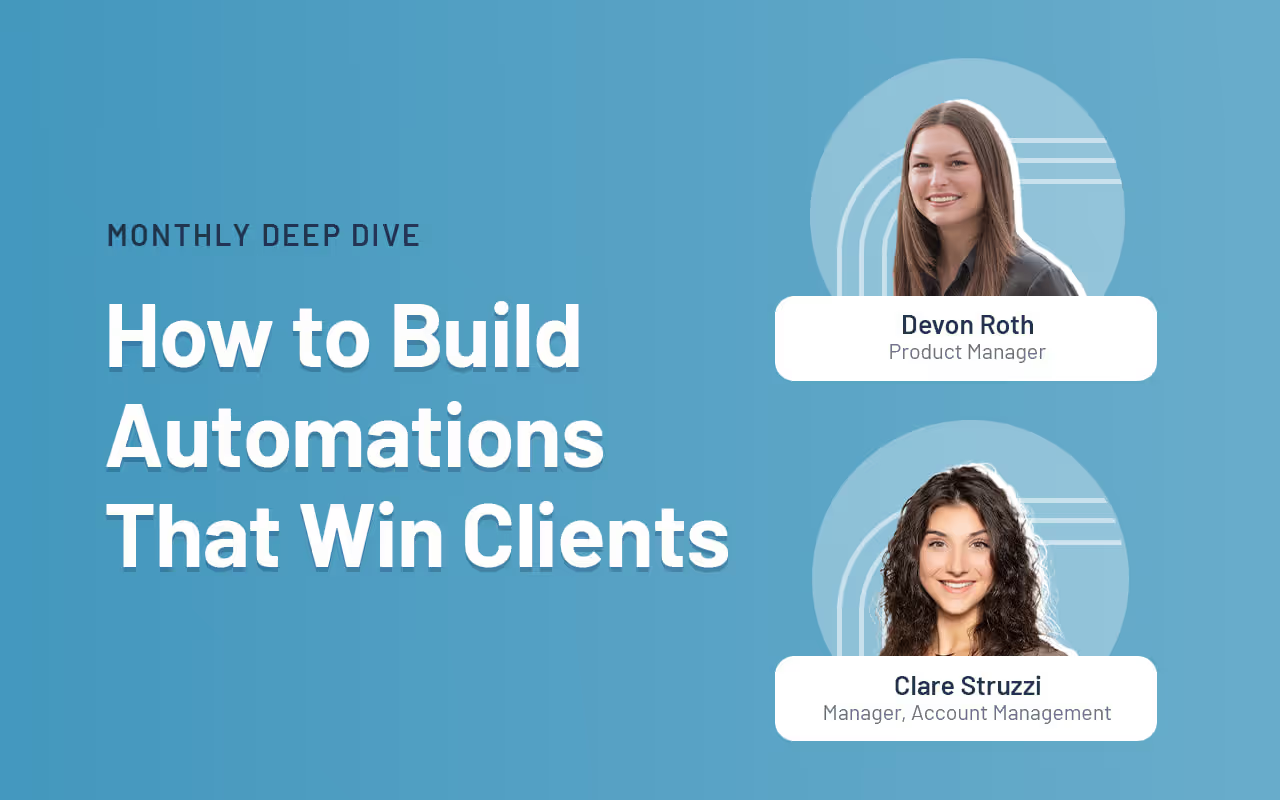
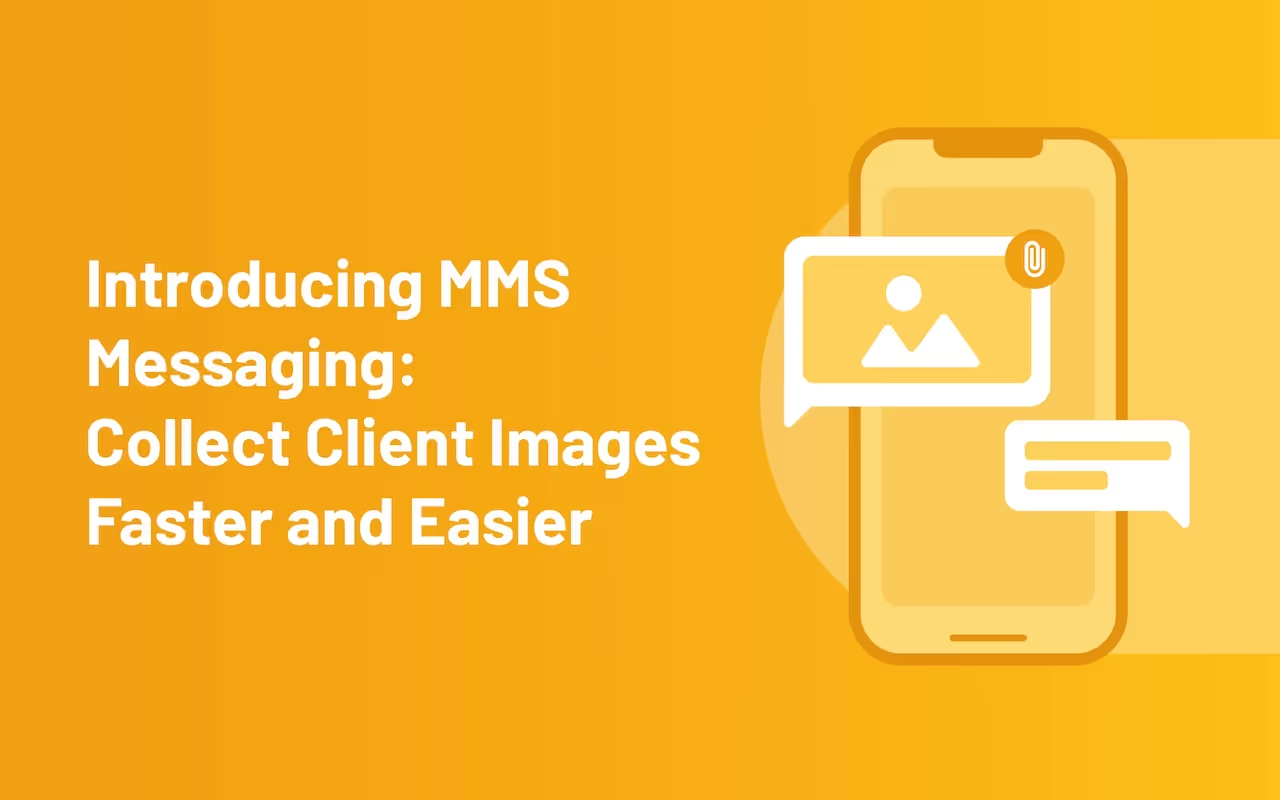
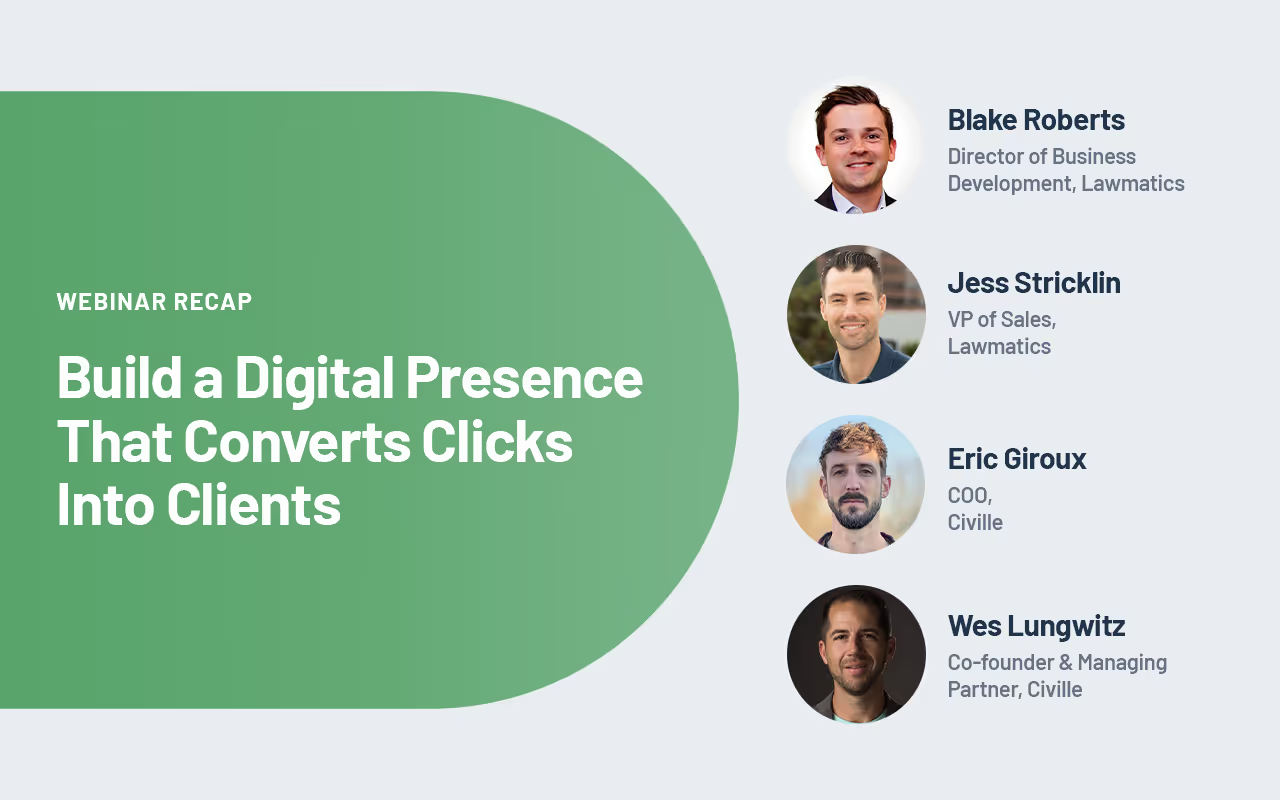
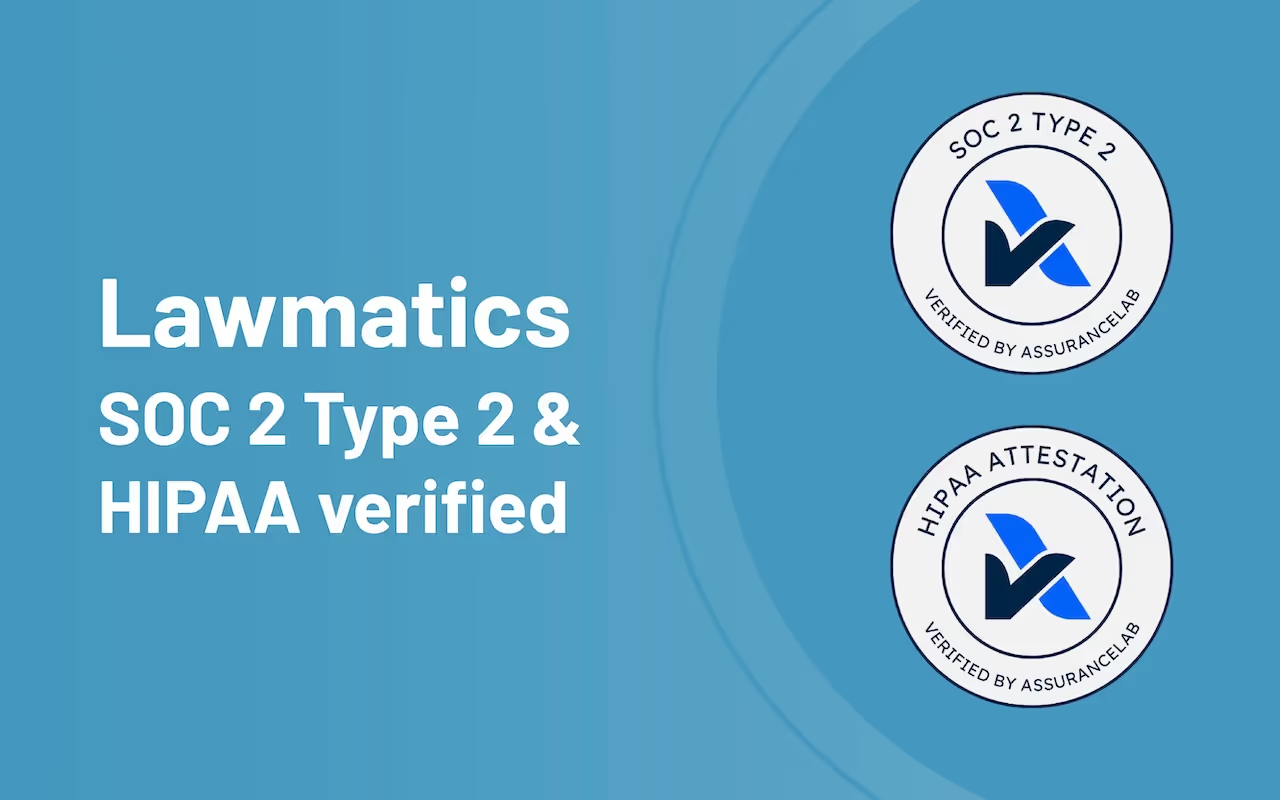
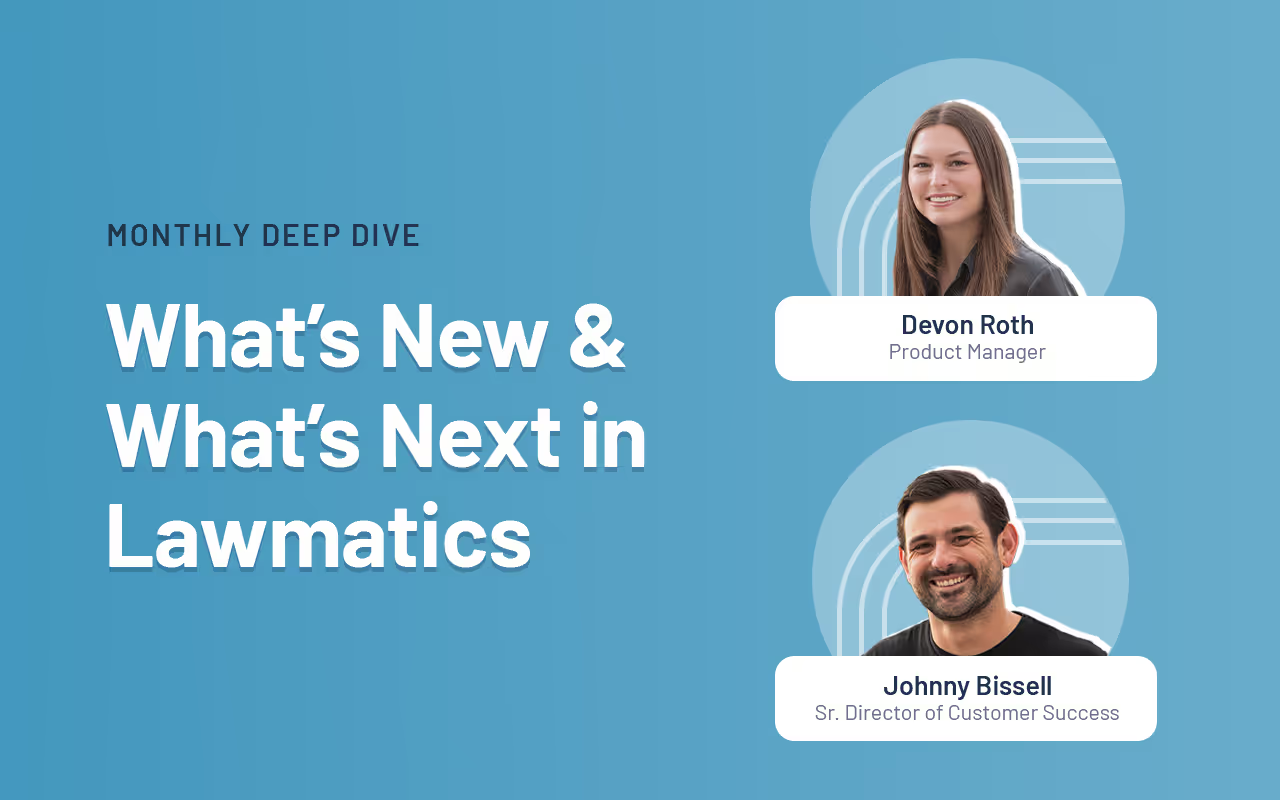
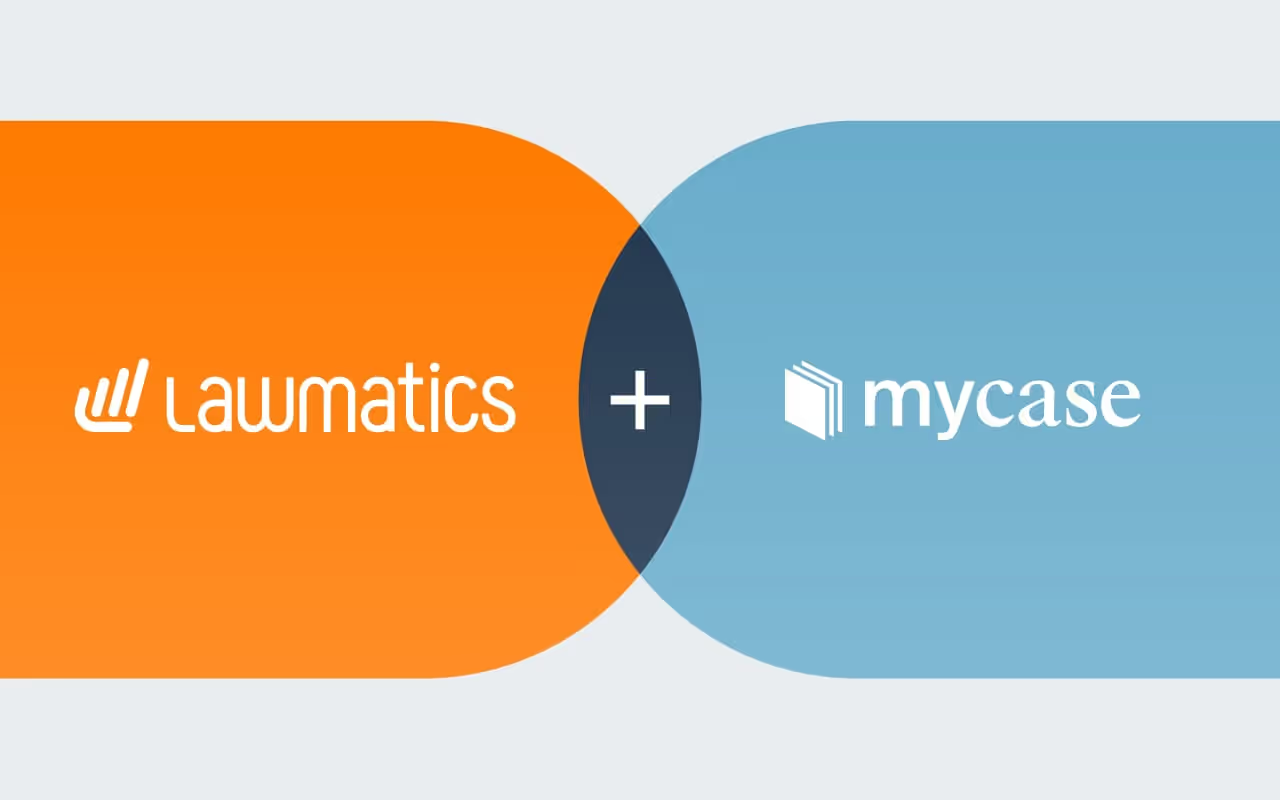
.avif)
.avif)

.avif)
